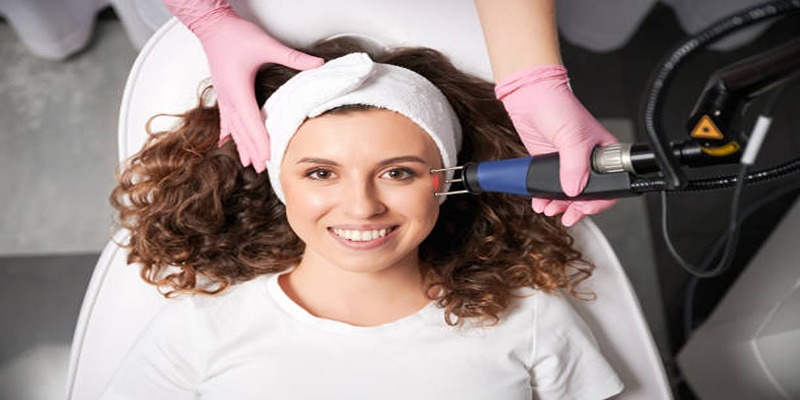CO2 laser resurfacing is a sought-after cosmetic treatment that rejuvenates the skin by diminishing wrinkles, scars, and other imperfections. This comprehensive guide walks you through every stepfrom understanding the fundamentals of CO2 laser resurfacing to preparing for the procedure and knowing what to anticipate during recovery. Renowned for its precision and efficacy, this method smooths the skin to enhance a youthful appearance. Whether you're exploring this treatment for the first time or refreshing your knowledge, this guide simplifies the process for clarity and ease of understanding.
What is CO2 Laser Resurfacing?

Fractional carbon dioxide laser therapy or sometimes referred to as CO2 laser resurfacing is a skin treatment where light is applied to the affected skin in an effort to reduce the outer layer and, with it, the imperfections. This process promotes creation of collagen and also brings out healthier and smoother skin as compared to the outer layer.
The wound of the CO2 laser confronts both the dermal and the subdermal layers of the skin that is why it is effective from many problems such as wrinkles, scar, sun damage, age spots, and skin roughness. It may also be useful for pulling up sagging skin and decreasing large pores.
Preparation for the Procedure
To those who are willing to try CO2 laser resurfacing, it is strongly recommended that a dermatologist or a plastic surgeon specializes in laser surgery is consulted beforehand. The practitioner will assess your skin type and your medical records in order to decide whether or not you are fit for the procedure.
Your doctor will instruct you to avoid taking particular medicines, including aspirin, that may slow blood clotting before the procedure. It is also advisable to cease smoking, and where possible reduce alcohol intake to afford better chances for proper healing.
On the day of the procedure, make sure to arrive with a clean face free of makeup or skincare products. Your doctor may apply a numbing cream or local anesthesia to minimize any discomfort during the treatment.
The Procedure Process
CO2 laser resurfacing is typically an outpatient procedure that can take anywhere from 30 minutes to two hours, depending on the size and location of the treatment area. During the procedure, the doctor will use a handheld device to deliver short pulses of laser light to the skin. The intensity and depth of the laser can be adjusted for each individual's specific needs.
Some patients may experience a warm sensation or mild discomfort during the procedure, but this can be managed with numbing cream or pain medication if needed.
Once the treatment is complete, your doctor may apply a cooling mask or ointment to soothe the skin and reduce redness. In some cases, bandages may also be applied.
Post-Treatment Care
After the procedure, it's crucial to follow your doctor's post-treatment care instructions for optimal healing and results. These may include:
- Regularly applying a moisturizer or ointment recommended by your doctor to keep the skin hydrated
- Avoiding sun exposure and using sunscreen with SPF 30 or higher when outdoors
- Gently cleansing the treated area with a mild cleanser
- Avoiding any strenuous activities or exercise that can cause sweating and irritation to the skin
- Not picking at any scabs or peeling skin as this can lead to infection and scarring.
What to Expect During Recovery
The recovery time for CO2 laser resurfacing can vary from person to person, but most people can expect to see their skin completely healed within 7-10 days.
During the first few days after treatment, it's normal to experience some redness, swelling, and mild discomfort. Your doctor may prescribe pain medication or recommend over-the-counter pain relievers if needed.
As your skin heals, you may notice some peeling or crusting in the treated area. This is a natural part of the healing process as the damaged skin is replaced with new, healthier skin. It's important not to pick at any scabs or peel off any skin prematurely as this can lead to complications and delays in healing.
After your skin has completely healed, you'll start to notice the benefits of your CO2 laser resurfacing treatment. These effects can endure for several years; however, maintaining a healthy skincare routine and protecting your skin from excessive sun exposure are crucial for extending the results.
Results and Expectations
CO2 laser resurfacing can provide significant improvements in skin texture, tone, and appearance. Results may vary depending on the severity of the initial skin concerns, but most patients report smoother, more youthful-looking skin after treatment.
It's important to keep in mind that CO2 laser resurfacing is not a one-time solution and may require multiple treatments for optimal results. Your doctor will work with you to create a personalized treatment plan based on your specific needs and goals.
Benefits of CO2 Laser Resurfacing
Aside from its effectiveness in treating a wide range of skin concerns, CO2 laser resurfacing has several other benefits, including:
- Minimally invasive: Unlike surgical procedures, CO2 laser resurfacing is minimally invasive and requires no incisions or stitches.
- Short recovery time: With adequate post-treatment care, most patients can return to their daily activities within a week.
- Long-lasting results: With proper skincare maintenance, the collagen stimulation and skin rejuvenation effects of CO2 laser resurfacing can last for several years.
Risks and Considerations

While generally safe, there are some risks associated with CO2 laser resurfacing that should be discussed with your doctor before undergoing treatment. These may include:
- Infection:The damaged skin barrier after the procedure can increase the risk of infection. It's essential to follow post-treatment care instructions and keep the treated area clean to prevent infection.
- Scarring: In rare cases, scarring may occur as a result of CO2 laser resurfacing. This is more likely to happen if proper wound care instructions are not followed.
- Skin pigmentation changes: Some patients may experience temporary or permanent changes in skin pigmentation after treatment. This is more common in individuals with darker skin tones.
Conclusion
CO2 laser resurfacing is a safe and effective treatment for a variety of skin concerns, and with proper preparation and post-treatment care, you can achieve smoother, healthier-looking skin. Be sure to consult with a qualified professional before undergoing the procedure to ensure the best results for your specific needs. With patience and diligence during recovery, you can enjoy long-lasting benefits from CO2 laser resurfacing. So if you're considering this treatment option, be sure to do your research and find a reputable doctor who can guide you through the process and help you achieve your desired results.











